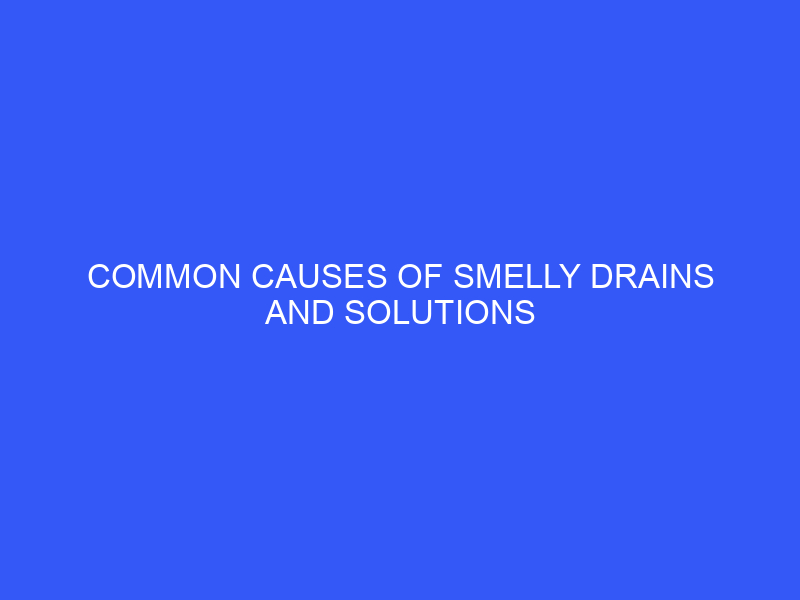A structure’s drainage system keeps all odours, including wastewater and sewage, away from regions like the kitchen and restroom. With a very much-planned drainage system, you shouldn’t stress over odour or foul smells. Notwithstanding, if you identify a foul odour in your restroom or kitchen, it shows that something is off-base somewhere else. You should fix the issue at the earliest opportunity. Here are the most well-known reasons behind smelly drains and how you might improve them.
What are the Causes of Smelly Drains?
A stinky drain indicates that something is amiss with your plumbing installation. The following are the most typical causes of smelly drains:
Tree Roots
The most prevalent source of stinking drains is tree roots. Tree roots gravitate toward drains because they are constantly seeking moisture. They continue to develop and increase as soon as they discover a water source, which can cause drain pipes to become clogged. You can identify this by hearing a gurgling noise when you use the faucet or flush the toilet. The solution is to contact an expert who will investigate the problem.
Old Pipes
Another major cause of stinking drains is using clay-cement pipes in homes built before the 1980s. Because clay-cement lines are prone to cracking, any movement underground can cause damage, resulting in pipe blockage and, as a result, smelly drains.
Mould
If you notice a musty odour in your bathroom or kitchen, mould is most likely the source of the smell. Mould is drawn to wet regions, making it a frequent visitor to drains. Mould emits tiny puffs of gas with a foul and toxic odour. Some people have reported headaches and dizziness as a result of this odour.
Sewer Gas Trap Issue
Every plumbing system has a P-trap. There is a U-shaped pipe in each bathroom, with one end connected to the septic tank and the other running up to the roof, and this serves as an outlet for sewage aromas to leave the house and allow fresh air to enter. The purpose of the bathroom P-trap is to protect the house from sewage fumes by collecting water after each toilet flush or tap use. The water becomes a snare, keeping the gas from leaking into the structure and obstructing the drains. Also, the P-trap is utilised in kitchens to get food and other kitchen wastes as they channel from the sink, keeping them from obstructing the plumbing system. This is a common issue with infrequently used taps.
Food and Organic Materials
Food and other organic items might become lodged in your home’s pipes without your knowledge. The components quickly begin to decompose, collecting bacteria and generating foul drainage.
Drain Flies
Sink flies are another name for drain flies. They are minor, but they can create enormous disruptions. The rotting stuff, mainly organic matter and stagnant water, draws flies. Drains and sewage pipes typically have laid eggs.
The disadvantage is that they increase and might cause drain odours if they aggregate in high quantities.
How Do You Clean Your Smelly Drains?
We all despise the rancid and foul odour generated by clogged pipes and drains caused by food and other organic things that stagnate and decompose, emitting foul odours. Anyway, how might you eliminate such scents and keep away from them later on?
They guarantee that anticipation is superior to fix. As a result, frequent maintenance of all your drains (bathroom, toilet, kitchen sink, and waste disposal systems) will assist in eliminating the stink that emanates from drains.
One of the two problems listed below causes a smelly drain. The first is an accumulation of organic debris in the pipe immediately connected to a specific drain, for example, soap and hair scum in the shower drain’s floor waste. This buildup isn’t enough to cause a clogged drain but can cause one in the future. A local blockage affects just one drain.
The second issue that could be causing dirty drains is a clogged sewage main. If so, you will see a foul smell coming from every one of your home’s drains.
Recognizing whether the issue is because of a nearby local clog or a blockage of the sewage main is essential and should be the initial step to dispose of the odour.
Selecting the remedy to use once you have identified the source of the odour will be simple.
Getting Rid of Smelly Drains Caused by Clogs
If the problem is limited to a single drain, for example, if your shower drain smells like sewer gas or rotten egg, the sludge around the drain entrance is most likely the source. If it’s in the shower, it could be from soap and hair scum buildup.
To address this issue, follow the steps outlined below.
In the Shower
- Clean up any buildup accumulated in the shower drain to eliminate smelly drains. If sludge is near your drain opening, wear gloves and remove everything you can reach with a wire coat hanger or even your fingers if required.
- An old toothbrush with enough force behind its bristles is a fantastic technique to travel further down the pipes without having too much trouble navigating around them. Brushing along pipe walls will dislodge almost everything lodged in those little places.
After you’ve removed the clog, perform the following to clean the pipes properly:
- Boil water and allow it to cool somewhat so it does not harm the pipe before pouring it down the drain.
- Pour one cup of white vinegar down the drain, then half a cup of bicarbon soap.
- Wait two hours before adding another kettle of hot water.
- Repeat this process several times, and if the stench persists, contact a professional plumber.
In the Kitchen
To cure a smelly sink drain in your kitchen, use a plunger or the same DIY combination of vinegar, hot water, and bicarb suggested before. If it doesn’t work, remove the S-trap to eliminate any water residue with your hand. Make the accompanying steps:
- Place a bucket underneath the pipe. Wear gloves and have old towels to blot up any surplus water.
- Unscrew the slip joint with a wrench.
- After removing the trap, clean the pipe with a cleaning brush or a rag wrapped around the end of a coat hanger. Transfer the line to a different sink and rinse it.
- After cleaning, assemble the S-bend and fasten the slip joint with a wrench.
How to Get Rid of a Smelly Drain Caused by a Blocked Sewer Main
Sewer gas could be the source of a foul odour coming from many drains throughout your property. If not addressed promptly, this odour rises from pipes and might create health problems. As soon as possible, contact a competent plumber.
In addition to the unpleasant odour, sewer gas harms your health. A lot of sewer gas in your home can cause nausea, headaches, weakness, vomiting, and other health problems. Vinegar or baking pop can’t tend to clog sewage lines since it is a delayed bomb. Endeavoring to address what is happening on your own will aggravate it. If addressed after some time, your sewer pipe may become stopped entirely. With all your drains connected to the sewer line, if the sewer pipe becomes blocked, the wastewater has no choice but to back up your pipes and out of the drain inside your home, a phenomenon known as sewage backup. It poses serious health risks.
Having your sewer unblocked on time not only saves your property from damage but also ensures the safety of your family and aids in the removal of unwanted odours.
FAQ’S
How do I stop my drains from smelling?
Run hot water for a few seconds before pouring one or two cups of baking soda into the drain plug hole. Then, pour in a couple of cups of hot vinegar. Allow it to bubble for an hour or two. Flush it out with hot water.
What is a natural remedy for a smelly sink drain?
White Vinegar, Baking Soda, and Rock Salt. For this, you require twelve cups baking soda, 1 cup vinegar, and 12 cups rock salt. After letting the solution sit for a time, add some boiling water. This can assist with the stink of the kitchen drain.
Is salt good for smelly drains?
The salt method is ineffective at removing odours, especially over lengthy periods. However, experts have discovered that this kitchen sink cleaning trick is not worth your effort and may cause worse difficulties in the long run.


